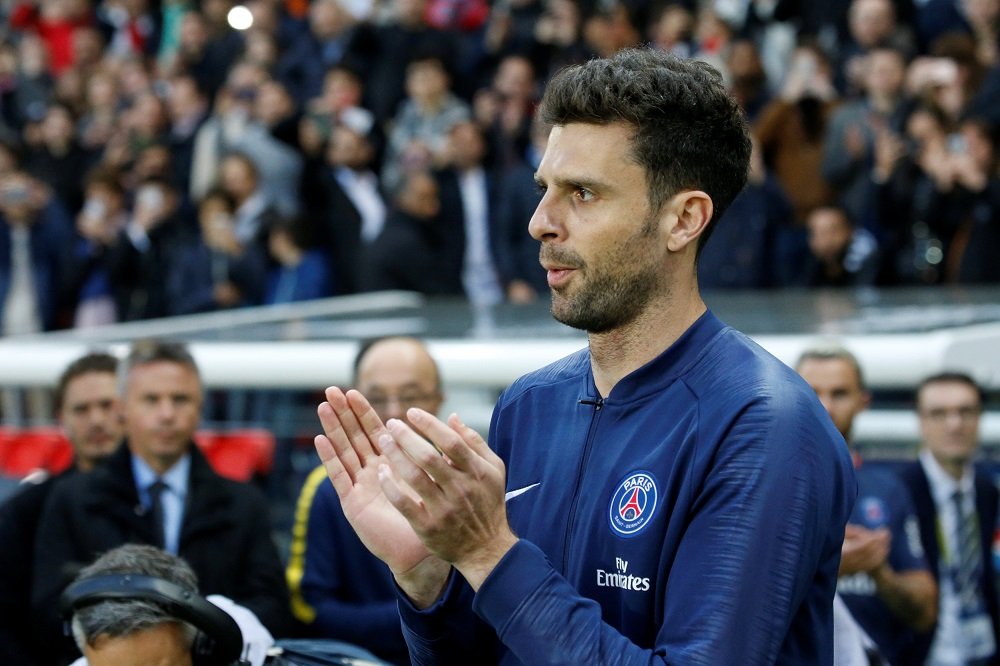“My idea is to play offensively. A short team that controls the game, high pressure and a lot of movement with and without the ball.”
“I want the player that has the ball to always have three or four solutions and two teammates close by to help. The difficulty in football is, often to do things simply but to control the base, pass and get free.”
“I don’t like the numbers of the field because they trick you. You can be super offensive with a 5-3-2 and defensive in a 4-3-3.”
Back in November last season, Thiago Motta took the world by surprise when he actually presented the idea of deploying a team in a 2-7-2 formation. The PSG U19 coach, however, was misinterpreted in many aspects.
While it’s but natural to think of 2 defenders, 2 strikers and 7 midfielders when we read the formation, that isn’t how it is meant to be. Keen observers will know that a midfield seven alongside a defensive and offensive duo means the goalkeeper has also been assigned advanced duties rather than just manning the posts.
But, does a midfield seven also require the goalkeeper to leave his position behind and advance to the center of the part? If that actually is the case, the half-line goals scored by David Beckham and Wayne Rooney would become a weekly routine.
But that’s not how the 2-7-2 actually works. First and foremost, the secret lies in how we read the formation. While a formation is usually read vertically, the 2-7-2 is exactly the opposite.
In this format, the blocks are read laterally. Simply put, it has two players in the first block on the left flank, then seven players in the central block, and two more on the right flank constituting the third block. When read vertically, it just looks like a 4-1-4-1 or a 4-3-3 formation.
Motta said that the 2-7-2 could be a revolution in the years to come. The Frenchman might as well be true in that sense. The 2-7-2 tends to actually revolutionize the goalkeeper, expanding the horizons of his role.
While a traditional shot-stopper is assigned the duty of manning the posts, the modern goalkeeper is deployed in a more advanced role where he acts as the first attacker and creator of the team. As Motta puts it, the goalkeeper tries to pick out players with incisive long passes and create chances in the final third or wide areas with the help of his vision.
In a 2-7-2 format, the goalkeeper tends to foray forward but stays behind the defensive line. The idea is to create more pressure by helping the defensive line press higher so as to suffocate the opposition and force them into making mistakes. Watching a goalkeeper higher up the pitch might also coax the opposition attackers into pressing high, creating space between themselves and the midfield for teams to exploit.
Coming to the back four, the two wing-backs exploit the half-spaces to offer width during attacks while the defensive midfielder slots in at the back to provide more defensive cover. The remaining two central midfielders take up positions as two number 10s with the idea of exploiting the spaces between the midfield and defensive lines of the opposition. The wide players and the new no 10s also tend to swap places to create confusion, thereby maintaining superiority in the central area of the pitch. Given the presence of more bodies in the central area, Motta’s formation allows a player to create triangles along with help from players in the wide and half-spaces, thereby adhering to his philosophy of creating three or four solutions
The inclusion of the keeper in the midfield is what separates this formation from the lot, albeit the description of his role is already in use. Manchester City’s Ederson and Everton’s Jordan Pickford are often seen distributing inch-perfect passes and using their vision to initiate a high presid
The idea of using sweeper keepers who patrol beyond the penalty box is to lure the opposition into initiating a press. With two center backs to his aid and a dropping defensive midfielder, the goalkeeper’s job is to keep hold of the ball and maintain fluidity with an interchange of short passes with the three options that are available to him. As the opposition presses further with three players coming on to the two defenders and the defensive midfielder, the advanced wing-backs are often left unmarked for the goalkeeper to pick them out with a neat, weighted pass, thereby kickstarting a quick counter-attack.
With a number of goalkeepers like Marc-Andre Ter Stegen, Manuel Neuer and Hugo Lloris also being conferred with responsibilities to create chances, the role of the goalkeeper is definitely in for a revolutionary change.










